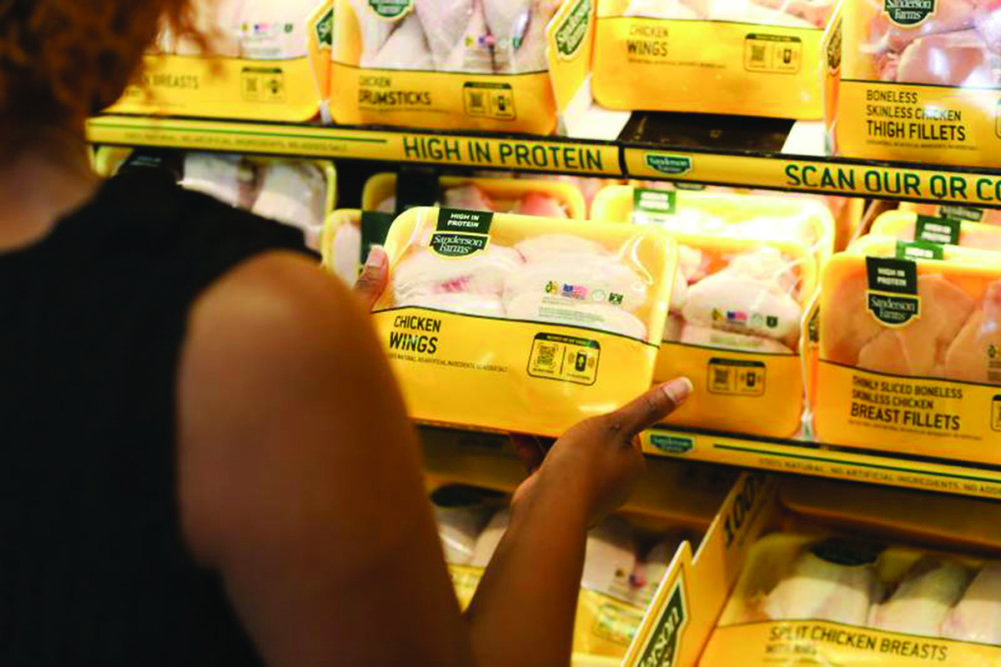Demand for fresh chicken sold in grocery stores is steady and looking more like pre-Covid demand, but inflation is still very much on producers’ and retailers’ minds, industry experts say.
“We’re experiencing more normalized seasonality shifts,” said David Gadd, vice president of retail sales for Wayne-Sanderson Farms. “In 2024, we’re optimistic that demand will remain strong, especially in our core markets. And we feel well positioned to meet that demand.”
Sustainable (non-polystyrene) packaging will be a major focus for Wayne-Sanderson this year, Gadd said. The company is constantly researching and testing alternative options for fresh tray pack chicken and is optimistic about rolling out new options for interested retail partners soon.
The merger of Wayne Farms and Sanderson Farms has given the combined company more capability to introduce other new products, Gadd said.
Also in the pipeline are NAE fresh tray pack chicken products, which should be available soon. Products with vegetable-fed and other clean-label claims are also on the horizon.
“They’re options we’re putting on the table for our retail partners to respond to the customer demand in those areas,” Gadd said.
Wayne-Sanderson is also developing fully cooked options for the frozen foods section, such as wings and breaded white meat products.
“As we continue to expand our offerings in the retail segment, we believe the addition of these products provides our retail partners more offerings for their shoppers who continue to expect more offerings across the meat case.”
Inflation’s long shadow
A few decades ago, another period in our nation’s history when food inflation was also a hot issue, the US government rolled out a “whip inflation now” (WIN) program.
Chicken marketers were among the many throughout the food industry who wore WIN buttons to show their support for the campaign, said Tom Super, spokesperson for the National Chicken Council.
Whether or not it’s time to bust out those buttons again, food inflation continues to be a challenge for many, if not most, grocery shoppers, Super said.
Despite that, consumers are actively seeking more convenient foods that often are a bit more costly than products used for scratch preparation and cooking.
For instance, price promotions for favorite meat department foods like boneless/skinless chicken breasts are “likely to be an inefficient strategy to boost meat department sales,” according to Circana.
Such measures “don’t take into account consumer wants and needs beyond finding a good price.” Instead, retailers should think of pushing affordable fresh ready-to-heat chicken products that combine convenience and value.
“Convenience yes, good nutrition yes, affordable please,” Super said. “Chicken marketers are more fully recognizing this dynamic and adroitly working within the expanding supermarket fresh meat department to meet these ‘needs.’”
Consumer surveys have found that food inflation over the past two years has caused well more than half of food shoppers to change their grocery buying pattern.
People are looking for ways to adjust and adapt to higher prices, Super said, and fortunately for chicken producers and their retail partners, chicken has become even more of a go-to protein.
For the 52 weeks ending Oct. 27, for instance, chicken volume is up 1.4% while other meats are down — and overall meat volume is down 1.1%, according to Circana’s latest Fresh Center of Excellence report.
In addition, chicken dollar sales are up 3.5%, while overall meat department sales are up just 0.4%.
Getting the word out
Educating consumers about not only the cost but value of the chicken they’re buying at retail is more crucial than ever, Gadd said.
“Our Sanderson Farms brand markets to showcase the variety we offer, from cut to flavor as well as continuing to emphasize the overall health and affordability benefits of chicken.”
One example: on packaging for Sanderson Farms Chicken the company includes a QR code that consumers can scan for recipe ideas based on that cut, which is changed regularly to keep consumers inspired.
Wayne-Sanderson is also strengthening its social media presence to make sure recipes using its products reach as many consumers as possible.
“We know that a vast majority of people use social media for food inspiration,” Gadd said. “And they’re turning to platforms like Pinterest, TikTok, YouTube and Instagram to regularly find ideas for cooking that fits their lifestyle.”
Wayne-Sanderson partners with creators who “create inspiring content that aligns with what our audiences are looking for when it comes to dinner,” Gadd said. Later in 2024, the company expects to see more online AI tools that set out to help make shopping and cooking processes easier — tools like Tasty’s AI-powered sous chef Botatouille.
Wayne-Sanderson also uses its social channels daily to respond to consumers’ comments and questions.
These connections, Gadd said, often lead to meaningful conversations providing valuable insight into current likes and dislikes, behaviors and wishes, which in turn inspires the company’s communication strategy.
In addition, Wayne-Sanderson conducts one or two formal research studies every year using focus groups, journaling, ethnographies and other sources of information to drill down into important segments for the fresh chicken category.
Hybrid grocery shopping - a mix of in-person and online grocery shopping – is another trend Wayne-Sanderson will be tracking closely this year, Gadd said.
“It’s here to stay. It will be important for brands to think about showing up in both journeys.”
This article is an excerpt from the February 2024 issue of Supermarket Perimeter. You can read the entire Chicken feature and more in the digital edition here.

